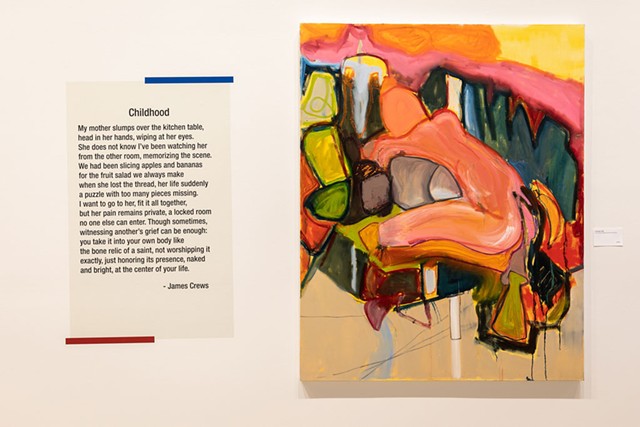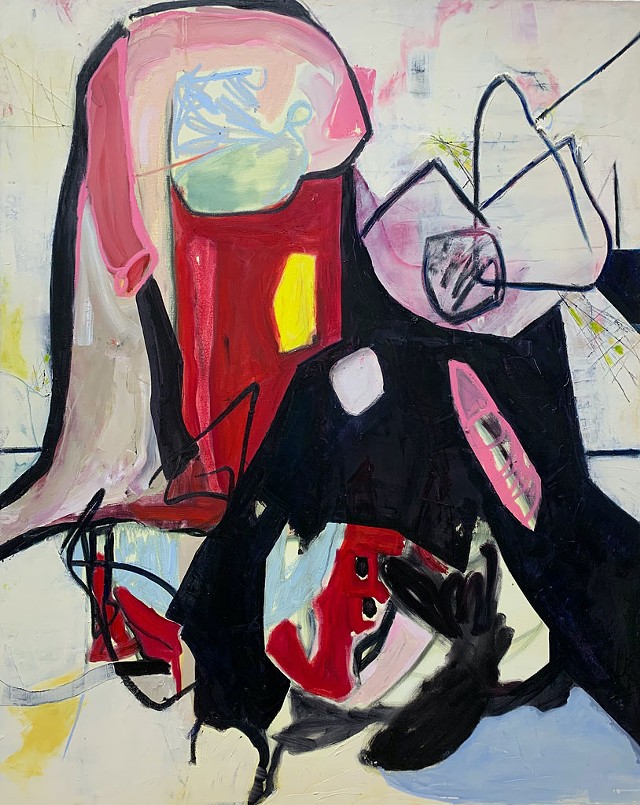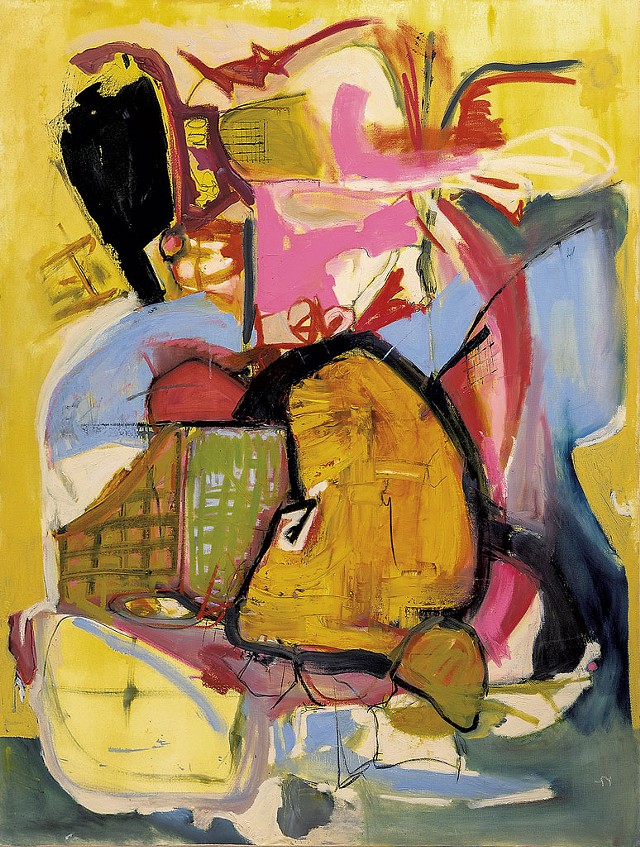
- Courtesy
- "Childhood" by James Crews and "Surrender" by Gail Winbury
The Elizabeth de C. Wilson Museum at the Southern Vermont Arts Center is imposingly lofty: Its main 3,000-square-foot exhibition space rises to a vaulted ceiling 40 feet overhead. Yet New Jersey artist Gail Winbury's exhibition, "The Girl Who Drew Memories," holds its own in the room with large-scale, mainly 48-by-60-inch abstract canvases on one side and 50 smaller collages on the other.
Winbury, a practicing psychologist and coach, has also been a full-time artist for the past 15 years and began showing her work in 2010. The oil paintings on view are the majority of a series of 15 made between 2018 and 2020 titled "The Other Side." Each painting tackles a childhood memory and its accompanying mood and emotions, whether terrifying or blissful. The abstract expressionist works are large and gestural with an emphasis on color, and the paint is thickly applied, textured and scraped.
Winbury's abstract collages were born of necessity: Her studio at a 2015 residency at the BAU Institute in Otranto, Italy, lacked running water, making brush cleanup difficult. So, she turned to available materials — art magazines, catalogs and masking tape — and began making collaged compositions. They grew to include tissue paper, beads and other materials.
Though technically a solo show, "The Girl Who Drew Memories" can more accurately be called a collaboration of Winbury and curator Alison Crites, the arts center's manager of exhibitions and interpretive engagement.
Bringing her training in the latter specialty to bear, Crites asked seven local poets to spend four weeks writing a poem in response to a Winbury painting of their choice. The resulting poems are printed in a format nearly as large as the paintings and artfully taped beside the visual works that inspired them.
The poets — David Crews, James Crews (no relation), Robbi Hartt, Rachel Michaud, Charles Rossiter, Michelle Wiegers and Berta Winiker — worked on their poems without knowing much about Winbury or even the paintings' titles. (The exception is David Crews' poem "Door Open/ Space Song" written in response to Winbury's "Door Open").
The result of this curatorial choice is that the viewer is engaged in several exercises at once: absorbing a visual work, interpreting a poem, deciding how the poem responds to the artwork and formulating one's own response to the artwork. (Another pursuit might be judging whether the poems stand on their own despite being secondary to the art in this context.) This reviewer found the process challenging, but a free booklet reproducing the paired poems and paintings affords more leisurely study.

- Amy Lilly
- "The Fear Monger"
Winbury states in a short biographical film on view at the show that abstract art "has the capacity to communicate experiences that we can't put into verbal language." But poetry is different, the artist explained during a phone call.
"I think really good imagistic poets paint, too — with words," she said.
According to her artist's statement, Winbury was impressed with the poets' responses and even "wept at the beauty and poignancy" of their poems.
While giving Seven Days a tour of the show recently, Crites said of her curatorial choice, "Upon reflection, it was a huge leap of faith for both Gail and the poets" — that is, for Winbury to be so open to ceding interpretation of her work to poets, and for the poets to trust their own interpretations after being given little context.
Another work of literature inspired Crites to coin the exhibition's title, "The Girl Who Drew Memories." The phrase echoes the title of a Japanese fairy tale that was the artist's favorite when she was a child: "The Boy Who Drew Cats," which inspired the exhibition's final painting, "Her Favorite Fairytale." In the story, a boy shunned for drawing cats on walls ends up saving a community from the rat-ghoul that has been terrorizing them when his cat drawings kill the ghoul in the night.
Crites encourages viewers to write about their own favorite childhood stories at a "response station" — an old card catalog stand provided by Winbury, whose mother was a librarian. On it sits a copy of Winbury's treasured book of Japanese tales. (Crites found the copy on eBay.) Winbury whimsically labeled the stand's 15 drawers with phrases such as "Open Me," "King and Queen" and "Meow" and populated some drawers with vignettes using small figurines or cutouts. Viewers can deposit their written responses in drawers of their choice.
On the collage side of the exhibition, Winbury and Crites grouped her works thematically: "Family," "Travel," "Play" — even "Non-Representational," though many of the collages could fit in that category. And Crites created a maker station stocked with materials where visitors can create their own collage postcards.
Winbury's use of the third person in her painting titles — "She Hid in Small Places," "She Sat on His Shoulders," "Her Sweater" — is meant to "allow viewers to enter the painting, to reflect on their own childhood memories," Winbury said by phone.

- Courtesy
- "Door Open"
It's also a distancing mechanism. While her art making is therapeutic to a certain extent, this series was a way for Winbury to put some painful personal memories at arm's length.
"It felt very good; I can talk about the paintings and the memories in a much more dispassionate way," she averred.
Winbury even marshals materials to obscure those memories. In "The Fear Monger," she used oil, cold wax, pigment stick and sumi ink to create a composition in which angular swaths of black outline and surround rough, vaguely figural shapes. In an artist's statement that Winbury provided for an earlier exhibition of her "Other Side" series, she explains her use of cold wax, a dense paste: "Creating a veiled distance, cold wax reveals, distorts and shields history." By layering and obscuring color and line, the statement continues, "it is as if truth is surely hidden or tucked away."
Crites said she and Winbury decided not to make the exhibition about the artist's personal history.
"It's really important to her — an aspiration of her work — that others' memories are evoked," Crites explained.
Yet it surely does no harm to know, as Winbury revealed to Crites, that the blue slashes composing the face of one looming figure in "The Fear Monger" is a reference to Winbury's memory of her father's lips turning blue in anger. More vivid contextual details such as that one would have gone far to cement this intriguing painter's works in visitors' memories.









Comments
Comments are closed.
From 2014-2020, Seven Days allowed readers to comment on all stories posted on our website. While we've appreciated the suggestions and insights, right now Seven Days is prioritizing our core mission — producing high-quality, responsible local journalism — over moderating online debates between readers.
To criticize, correct or praise our reporting, please send us a letter to the editor or send us a tip. We’ll check it out and report the results.
Online comments may return when we have better tech tools for managing them. Thanks for reading.